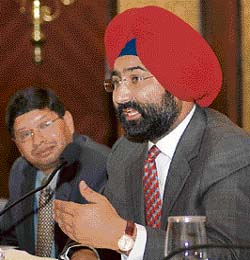
Malvinder Went To Seek Ally For R&D Unit, Ended Up Selling Co
IT BEGAN with the Ranbaxy management looking for an investor for its R&D unit and ended with them finding a buyer for the parent company. And ironically, while Ranbaxy has been sold off, the new owners have decided to retain the R&D unit within the company.
The story goes that somewhere around March, Ranbaxy CEO Malvinder Singh and his COO Atul Sobti met with Daiichi Sankyo executives in Tokyo to explore the possibility of a partnership for its new drug discovery research (NDDR) business which it planned to demerge into a separate company. Like other Indian pharma companies Ranbaxy had announced that it had decided that it hive-off this unit and company executives were engaged in dialogue with several companies for an alliance in the R&D front.
But Daiichi had other ideas. It expressed its interest to buy into Ranbaxy. It was in the process of setting up a wholly-owned subsidiary in the country, headed by another ex-Ranbaxy executive D Vijendran The Japanese company planned to run a full-fledged operations in India and had long-terms plans for India. Ranbaxy has a strong presence in the Japanese generic market and Daiichi was aware of its strengths As Daicchi’s CEO Takashi Shoda said on Wednesday: “In India, we have only considered Ranbaxy as a prospective partner.”
It is learnt that Mr Singh was lukewarm to that proposal at that moment but when he came back to India he discussed it with his close confidants, including his younger brother and Fortis HealthCare CEO Shivinder Singh and Religare CEO Sunil Godhwani (who is also called the third pillar of the Ranbaxy promoter group). Both of them were of the view that Daiichi’s proposal could be examined and not be dismissed outright.
And so discussions began silently and at the highest levels. From Ranbaxy’s side, Mr Singh and Mr Godhwani led the negotiations and it is believed that even Mr Sobti, the second highest ranking Ranbaxy executive after the CEO, was not kept completely in the loop. “Malvinder kept his cards close to the chest,” said a company insider.
From Daiichi’s side, apart from its CEO, a key figure involved in the discussions, was the company’s board member, global strategy, Une Tsutomu. The Japanese company was advised by Nomura Securities Nomura had earlier in India advised Mitsui to pull out of $700 million Sesa Goa by selling stake to Sterlite and was also part of the consortium which helped Sterlite raise $1.2 billion ADS two years ago. As negotiations moved ahead, few senior executives had a sense about ‘some discussions’ but believed that the talks were for a strategic alliance.
Ranbaxy share prices perked up
HOWEVER, a couple of weeks before the announcement, few key executives and select board members, including ex-Ranbaxy CFO and an old Parvinder Singh-loyalist Vinay Kaul, were informed about the promoters plan to sell their entire stake.
Meanwhile, the Ranbaxy share price started going up. Whether by sheer coincidence or because of positive news flow, the company’s stock price shot up by 28% from Rs 443 on April 1 to Rs 568 on June 9, a day before the deal was announced. The rising scrip price would have definitely strengthened the negotiating position of the sellers.
Of course, Daiichi was not the only company that wanted to buy out Ranbaxy. Unconfirmed reports suggest that last year the company had rejected private equity giant Carlyle’s proposal to buy it out. GSK, too, is learnt to have proposed a buyout at a higher price than Daichi. Ultimately, the promoters did not sell-out to the highest bidder. They chose a buyer who would ensure continuity in management, provide a better fit, and not destabilise operations
No comments:
Post a Comment